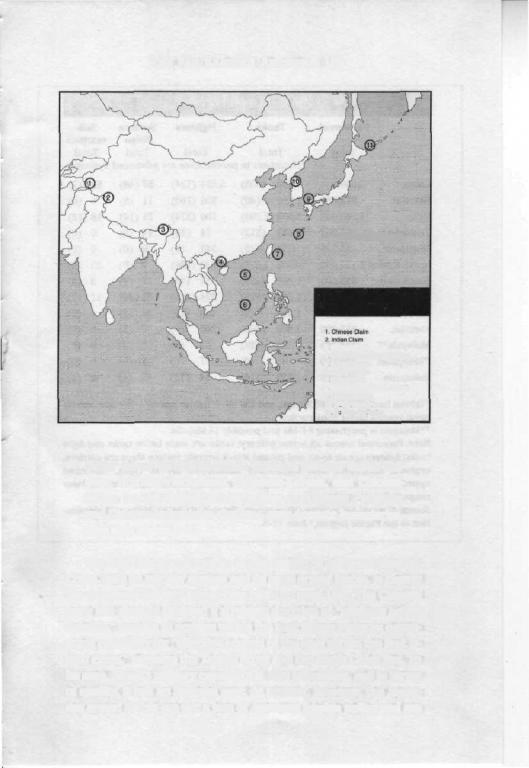
Grand_Chessboard
.pdf
THE FAR EASTERN ANCHOR 153
side growing political uncertainty. Asian economic growth may in fact even contribute to that uncertainty, because prosperity obscures the region's political vulnerabilities even as it intensifies national ambitions and expands social expectations.
That Asia is an economic success without parallel in human development goes without saying. Just a few basic statistics dramatically highlight that reality. Less than four decades ago, East Asia (including Japan) accounted for a mere 4 percent or so of the world's total GNP, while North America led with approximately 35-40 percent; by the mid-1990s, the two regions were roughly equal (in the neighborhood of 25 percent). Moreover, Asia's pace of growth has been historically unprecedented. Economists have noted that in the takeoff stage of industrialization, Great Britain took more than fifty years and America just somewhat less than fifty years to double their respective outputs per head, whereas both China and South Korea accomplished the same gain in approximately ten years. Barring some massive regional disruption, within a quarter of a century, Asia is likely to outstrip both North America and Europe in total GNP.
However, in addition to becoming the world's center of economic gravity, Asia is also its potential political volcano. Although surpassing Europe in economic development, Asia is singularly deficient in regional political development. It lacks the cooperative multilateral structures that so dominate the European political landscape and that dilute, absorb, and contain Europe's more traditional territorial, ethnic, and national conflicts. There is nothing comparable in Asia to either the European Union or NATO. None of the three regional associations—ASEAN (Association of Southeast Asian Nations), ARF (Asian Regional Forum, ASEAN's platform for a political-security dialogue), and APEC (Asia-Pacific Economic Cooperation Group)—even remotely approximates the web of multilateral and regional cooperative ties that bind Europe together.
On the contrary, Asia is today the seat of the world's greatest concentration of rising and recently awakened mass nationalisms, fueled by sudden access to mass communications, hyperactivated by expanding social expectations generated by growing economic prosperity as well as by widening disparities in social wealth, and made more susceptible to political mobilization by the explosive increase both in population and urbanization. This condition is

154 THE GRAND CHESSBOARD
rendered even more ominous by the scale of Asia's arms buildup. In 1995, the region became—according to the International Institute of Strategic Studies—the world's biggest importer of arms, outstripping Europe and the Middle East.
In brief, East Asia is seething with dynamic activity, which so far has been channeled in peaceful directions by the region's rapid pace of economic growth. But that safety valve could at some point be overwhelmed by unleashed political passions, once they have been triggered by some flash point, even a relatively trivial one. The potential for such a flash point is present in a large number of contentious issues, each vulnerable to demagogic exploitation and thus potentially explosive:
•China's resentment of Taiwan's separate status is intensifying as China gains in strength and as the increasingly prosperous Taiwan begins to flirt with a formally separate status as a nation-state.
•The Paracel and Spratly Islands in the South China Sea pose the risk of a collision between China and several Southeast Asian states over access to potentially valuable seabed energy sources, with China imperially viewing the South China Sea as its legitimate national patrimony.
•The Senkaku Islands are contested by both Japan and China (with the rivals Taiwan and mainland China ferociously of a single mind on this issue), and the historical rivalry for regional preeminence between Japan and China infuses this issue with symbolic significance as well.
"The division of Korea and the inherent instability of North Korea—made all the more dangerous by North Korea's quest for nuclear capability—pose the risk that a sudden explosion could engulf the peninsula in warfare, which in turn would engage the United States and indirectly involve Japan.
•The issue of the southernmost Kuril Islands, unilaterally seized in 1945 by the Soviet Union, continues to paralyze and poison Russo-Japanese relations.

THE FAR EASTERN ANCHOR 155
PACIFIC OCEAN
Uu mid dry ami Territorial
Disputes in Kast tola
|
3 |
Chinese Claim |
|
|
4 |
China-Vlelnarn Boi»r Friction |
|
INDIAN OCEAN |
5 |
Parecsl Islands |
|
6. Spratly Islands |
|||
|
|||
|
7 |
Prates Island |
|
|
8 |
Senkskj Islands i Diao-Yu-Tsi |
|
|
9 |
Uancourr Rocks |
|
|
10 D"iu'iM:n L'np |
||
|
11 N rrheni V'|-.i,i"s |
||
• Other latent territorial-ethnic conflicts involve Russo-Chi- nese, Chinese-Vietnamese, Japanese-Korean, and ChineseIndian border issues; ethnic unrest in Xinjiang Province; and Chinese-Indonesian disputes over oceanic boundaries. (See map above.)
The distribution of power in the region is also unbalanced. China, with its nuclear arsenal and its large armed forces, is clearly the dominant military power (see table on page 156). The Chinese navy has already adopted a strategic doctrine of "offshore active defense," seeking to acquire within the next fifteen years an oceangoing capability for "effective control of the seas within the first island chain," meaning the Taiwan Strait and the South China Sea. To be sure, Japan's military capability is also increasing, and in terms of quality, it has no regional peer. At present, however, the Japanese armed forces are not a tool of Japanese foreign policy and are

156 THE GRAND CHESSBOARD
|
|
Asian Armed Forces |
|
|
•i |
|||||
|
|
|
|
|
|
|||||
|
Personnel |
Tanks |
Fighters |
Surface |
Sub- |
|||||
|
|
|
|
Total |
Ships |
marines |
||||
|
Total |
Total |
Total |
Total |
||||||
|
|
(Numbers in parentheses are advanced systems) |
||||||||
China |
3,030.000 |
9,400 |
(500) |
5,224 |
(124) |
57 |
(40) |
53 |
(7) |
|
Pakistan |
577,000 |
1,890 |
(40) |
336 |
(160) |
11 (8) |
6 |
(6) |
||
India |
1,100,000 |
3,500 (2,700) |
700 |
(374) |
21 (14) |
18 |
(12) |
|||
Thailand |
295,000 |
633 (313) |
-74 |
(18) |
14 (6) |
0 |
(0) |
|||
Singapore |
55,500 |
350 |
(0) |
143 |
(6) |
0 |
(0) |
0 |
(0) |
|
North Korea |
1,127,000 |
4,200 (2,225) |
730 (136) |
3 |
(0) |
23 |
(0) |
|||
South Korea |
633,000 |
1,860 |
(450) |
334 |
(48) |
17 (9) |
3 |
(3) |
||
Japan |
237,700 |
1,200 |
(929) |
324 (231) |
62 (40) |
17(17) |
||||
Taiwan" |
442,000 |
1,400 |
(0) |
460 |
(10) |
38(11) |
4 |
(2) |
||
Vietnam |
857,000 |
1,900 |
(400) |
240 |
(0) |
7 |
(5) |
0 |
(0) |
|
Malaysia*" |
114,500 |
26 |
(26) |
50 |
|
(0) |
2 |
(0) |
0 |
(0) |
Philippines |
106,500 |
41 |
(0) |
7 |
|
(0) |
1 |
(0) |
0 |
(0) |
Indonesia |
270,900 |
235 |
(110) |
54 |
|
(12) |
17 (4) |
2 |
(2) |
|
"Taiwan has 150 F-16s, 60 Mirage, and 130 other fighter jets on order and several naval vessels under construction.
'"Malaysia is purchasing 8 F-18s and possibly IS MiG-29s.
Note: Personnel means all active military; tanks are main battle tanks and light tanks; fighters are air-to-air and ground attack aircraft; surface ships are carriers, cruisers, destroyers, and frigates;and submarines are all types. Advanced systems are at least mid-1960s design with advanced technologies, such as laser range finders for tanks.
Source: General Accounting Office report, "Impact of China's Military Modernization in the Pacific Region, June 1995.
largely viewed as an extension of the American military presence in the region.
The emergence of China has already prompted its southeastern neighbors to be increasingly deferential to Chinese concerns. It is noteworthy that during the minicrisis of early 1996 concerning Taiwan (in which China engaged in some threatening military maneuvers and barred air and sea access to a zone near Taiwan, precipitating a demonstrative U.S. naval deployment), the foreign minister of Thailand hastily declared that such a ban was normal,

THE FAR EASTERN ANCHOR 157
his Indonesian counterpart stated that this was purely a Chinese affair, and the Philippines and Malaysia declared a policy of neutrality on the issue.
The absence of a regional balance of power has in recent years prompted both Australia and Indonesia—heretofore rather wary of each other—to initiate growing military coordination. Both countries made little secret of their anxiety over the longer-range prospects of Chinese regional military domination and over the staying power of the United States as the region's security guarantor. This concern has also caused Singapore to explore closer security cooperation with these nations. In fact, throughout the region, the central but unanswered question among strategists has become this: "For how long can peace in the world's most populated and increasingly most armed region be assured by one hundred thousand American soldiers, and for how much longer in any case are they likely to stay?"
It is in this volatile setting of intensifying nationalisms, increasing populations, growing prosperity, exploding expectations, and overlapping power aspirations that genuinely tectonic shifts are occurring in East Asia's geopolitical landscape:
•China, whatever its specific prospects, is a rising and potentially dominant power.
•America's security role is becoming increasingly dependent on collaboration with Japan.
•Japan is groping for a more denned and autonomous political role.
•Russia's role has greatly diminished, while the formerly Russian-dominated Central Asia has become an object of international rivalry.
•The division of Korea is becoming less tenable, making Korea's future orientation a matter of increasing geostrategic interest to its major neighbors.
These tectonic shifts give added salience to the two central issues posed at the outset of this chapter.

158 THE GRAND CHESSBOARD
CHINA: NOT GLOBAL BUT REGIONAL
China's history is one of national greatness. The currently intense nationalism of the Chinese people is new only in its social pervasiveness, for it engages the self-identification and the emotions of an unprecedented number of Chinese. It is no longer a phenomenon confined largely to the students who, in the early years of this century, formed the precursors of the Kuomintang and the Chinese Communist Party. Chinese nationalism is now a mass phenomenon, defining the mindset of the world's most populous state.
That mindset has deep historical roots. History has predisposed the Chinese elite to think of China as the natural center of the world. In fact, the Chinese word for China—Chung-kuo, or the "Middle Kingdom"—both conveys the notion of China's centrality in world affairs and reaffirms the importance of national unity. That perspective also implies a hierarchical radiation of influence from the center to the peripheries, and thus China as the center expects deference from others.
Moreover, since time immemorial, China, with its vast population, has been a distinctive and proud civilization all its own. That civilization was highly advanced in all areas: philosophy, culture, the arts, social skills, technical inventiveness, and political power. The Chinese recall that until approximately 1600, China led the world in agricultural productivity, industrial innovation, and standard of living. But unlike the European and the Islamic civilizations, which have spawned some seventy-five-odd states, China has remained for most of its history a single state, which at the time of America's declaration of independence already contained more than 200 million people and was also the world's leading manufacturing power.
From that perspective, China's fall from greatness—the last 150 years of China's humiliation—is an aberration, a desecration of China's special quality, and a personal insult to every individual Chinese. It must be erased, and its perpetrators deserve due punishment. These perpetrators, in varying degrees, have primarily been four: Great Britain, Japan, Russia, and America—Great Britain, because of the Opium War and its consequent shameful debasement of China; Japan, because of the predatory wars spanning the last century, resulting in terrible (and still unrepented) infliction of suffering

THE FAR EASTERN ANCHOR 159
on the Chinese people; Russia, because of protracted encroachment on Chinese territories in the North as well as Stalin's domineering insensitivity toward Chinese self-esteem; and finally America, because through its Asian presence and support of Japan, it stands in the way of China's external aspirations.
In the Chinese view, two of these four powers have already been punished, so to speak, by history. Great Britain is no longer an empire, and the lowering of the Union Jack in Hong Kong forever closes that particularly painful chapter. Russia remains next door, though much diminished in stature, prestige, and territory. It is America and Japan that pose the most serious problems for China, and it is in the interaction with them that China's regional and global role will be substantively defined.
That definition, however, will depend in the first instance on how China itself evolves, on how much of an economic and military power it actually becomes. On this score, the prognosis for China is generally promising, though not without some major uncertainties and qualifications. Both the pace of China's economic growth and the scale of foreign investment in China—each among the highest in the world—provide the statistical basis for the conventional prognosis that within two decades or so China will become a global power, roughly on a par with the United States and Europe (assuming that the latter both unites and expands further). China might by then have a GDP considerably in excess of Japan's, and it already exceeds Russia's by a significant margin. That economic momentum should permit China to acquire military power on a scale that will be intimidating to all its neighbors, perhaps even to the more geographically distant opponents of China's aspirations. Further strengthened by the incorporation of Hong Kong and Macao, and perhaps also eventually by the political subordination of Taiwan, a Greater China will emerge not only as the dominant state in the Far East but as a world power of the first rank.
However, there are pitfalls in any such prognosis for the "Middle Kingdom's" inevitable resurrection as a central global power, the most obvious of which pertains to the mechanical reliance on statistical projection. That very error was made not long ago by those who prophesied that Japan would supplant the United States as the world's leading economy and that Japan was destined to be the new superstate. That perspective failed to take into

160 THE GRAND CHESSBOARD
account both the factor of Japan's economic vulnerability and the problem of political discontinuity—and the same error is being made by those who proclaim, and also fear, the inevitable emergence of China as a world power.
First of all, it is far from certain that China's explosive growth rates can be maintained over the next two decades. An economic slowdown cannot be excluded, and that by itself would discredit the conventional prognosis. In fact, for these rates to be sustained over a historically long period of time would require an unusually felicitous combination of effective national leadership, political tranquillity, domestic social discipline, high rates of savings, continued very high inflow of foreign investment, and regional stability. A prolonged combination of all of these positive factors is problematic.
Moreover, China's fast pace of growth is likely to produce political side effects that could limit its freedom of action. Chinese consumption of energy is already expanding at a rate that far exceeds domestic production. That excess will widen in any case, but especially so if China's rate of growth continues to be very high. The same is the case with food. Even given the slowdown in China's demographic growth, the Chinese population is still increasing in large absolute numbers, with food imports becoming more essential to internal well-being and political stability. Dependence on imports will not only impose strains on Chinese economic resources because of higher costs, but they will also make China more vulnerable to external pressures.
Militarily, China might partially qualify as a global power, since the very size of its economy and its high growth rates should enable its rulers to divert a significant ratio of the country's GDP to sustain a major expansion and modernization of China's armed forces, including a further buildup of its strategic nuclear arsenal. However, if that effort is excessive (and according to some Western estimates, in the mid-1990s it was already consuming about 20 percent of China's GDP), it could have the same negative effect on China's long-term economic growth that the failed attempt by the Soviet Union to compete in the arms race with the United States had on the Soviet economy. Furthermore, a major Chinese effort in this area would be likely to precipitate a countervailing Japanese arms buildup, thereby negating some of the political benefits of

THE FAR EASTERN ANCHOR 161
China's growing military prowess. And one must not ignore the fact that outside of its nuclear forces, China is likely to lack the means, for some time to come, to project its military power beyond its regional perimeter.
Tensions within China could also intensify, as a result of the inevitable unevenness of highly accelerated economic growth, driven heavily by the uninhibited exploitation of marginal advantages. The coastal South and East as well as the principal urban centers—more accessible to foreign investment and overseas trade—have so far been the major beneficiaries of China's impressive economic growth. In contrast, the inland rural areas in general and some of the outlying regions have lagged (with upward of 100 million rural unemployed).
The resulting resentment over regional disparities could begin to interact with anger over social inequality. China's rapid growth is widening the social gap in the distribution of wealth. At some point, either because the government may seek to limit such differences or because of social resentment from below, the regional disparities and the wealth gap could in turn impact on the country's political stability.
The second reason for cautious skepticism regarding the widespread prognoses of China's emergence during the next quarter of a century as a dominating power in global affairs is, indeed, the future of China's politics. The dynamic character of China's nonstatist economic transformation, including its social openness to the rest of the world, is not mutually compatible in the long run with a relatively closed and bureaucratically rigid Communist dictatorship. The proclaimed communism of that dictatorship is progressively less a matter of ideological commitment and more a matter of bureaucratic vested interest. The Chinese political elite remains organized as a self-contained, rigid, disciplined, and monopolistically intolerant hierarchy, still ritualistically proclaiming its fidelity to a dogma that is said to justify its power but that the same elite is no longer implementing socially. At some point, these two dimensions of life will collide head-on, unless Chinese politics begin to adapt gradually to the social imperatives of China's economics.
Thus, the issue of democratization cannot be evaded indefinitely, unless China suddenly makes the same decision it made in the year 1474: to isolate itself from the world, somewhat like con-

162 THE GRAND CHESSBOARD
temporary North Korea. To do that, China would have to recall its more than seventy thousand students currently studying in America, expel foreign businessmen, shut down its computers, and tear down satellite dishes from millions of Chinese homes. It would be an act of madness, reminiscent of the Cultural Revolution. Perhaps for a brief moment, in the context of a domestic struggle for power, a dogmatic wing of the ruling but fading Chinese Communist Party might attempt to emulate North Korea, but it could not be more than a brief episode. More likely than not, it would produce economic stagnation and then prompt a political explosion.
In any case, self-isolation would mean the end of any serious Chinese aspirations not only to global power but even to regional primacy. Moreover, the country has too much of a stake in access to the world, and that world, unlike that of 1474, is simply too intrusive to be effectively excluded. There is thus no practical, economically productive, and politically viable alternative to China's continued openness to the world.
Democratization will thus increasingly haunt China. Neither that issue nor the related question of human rights can be evaded for too long. China's future progress, as well as its emergence as a major power, will thus depend to a large degree on how skillfully the ruling Chinese elite handles the two related problems of power succession from the present generation of rulers to a younger team and of coping with the growing tension between the country's economic and political systems.
The Chinese leaders might perhaps succeed in promoting a slow and evolutionary transition to a very limited electoral authoritarianism, in which some low-level political choice is tolerated, and only thereafter move toward more genuine political pluralism, including more emphasis on incipient constitutional rule. Such a controlled transition would be more compatible with the imperatives of the increasingly open economic dynamics of the country than persistence in maintaining exclusive Party monopoly on political power.
To accomplish such controlled democratization, the Chinese political elite will have to be led with extraordinary skill, guided by pragmatic common sense, and stay relatively united and willing to yield some of its monopoly on power (and personal privilege)— while the population at large will have to be both patient and un-
